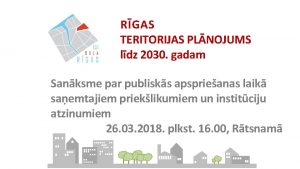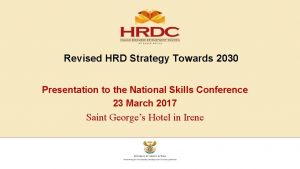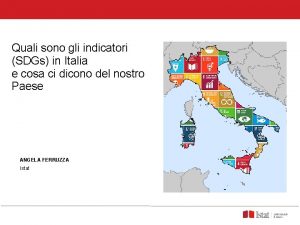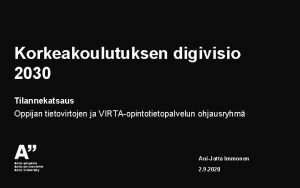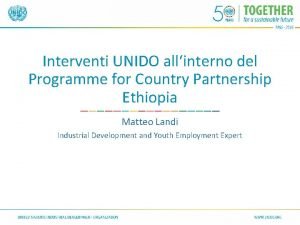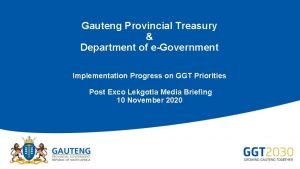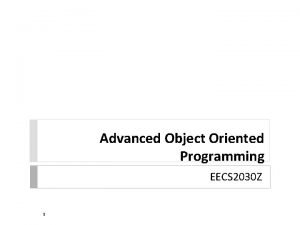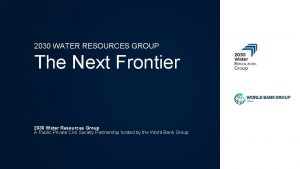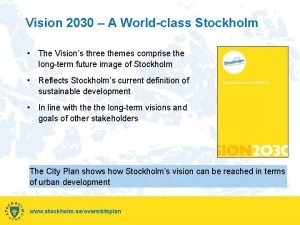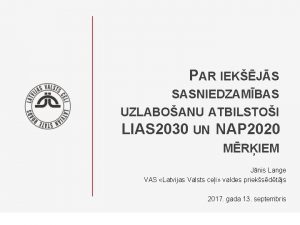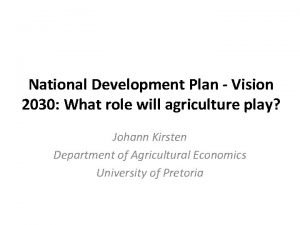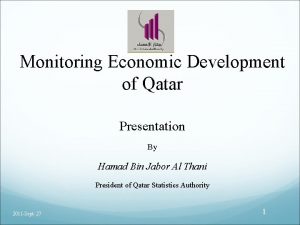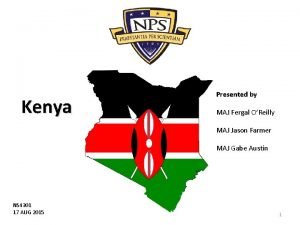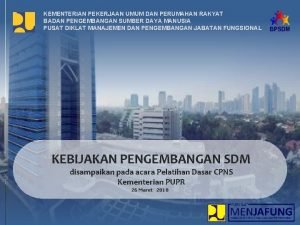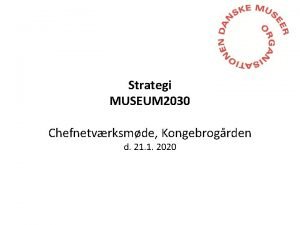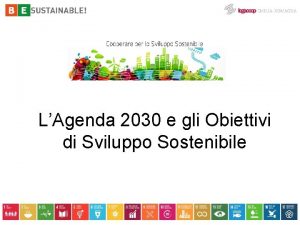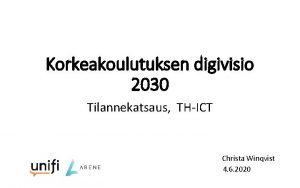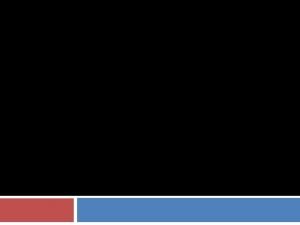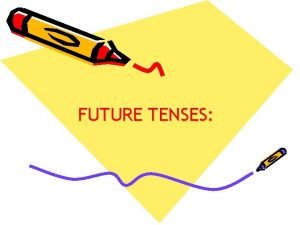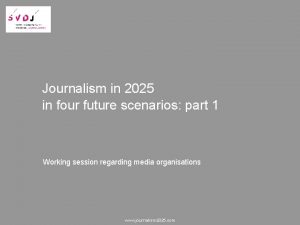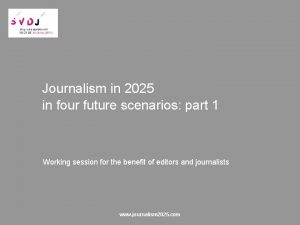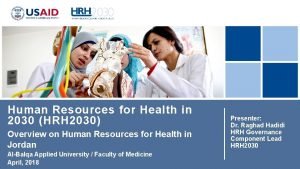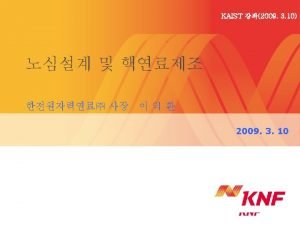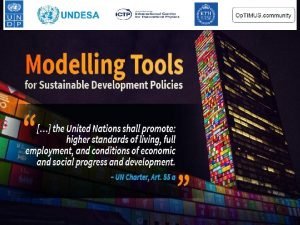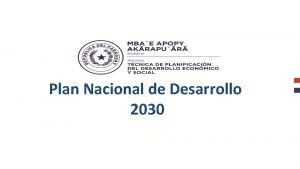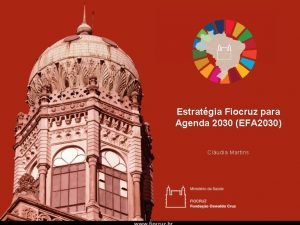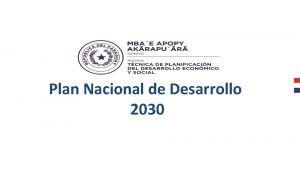The Future of Food 2015 2030 Four scenarios











































- Slides: 43

The Future of Food 2015 -2030 Four scenarios examining possible futures of the food system in South Africa

Developing the Transformative Scenarios These four scenarios seek to tell a connected set of stories about what the food system in South Africa might look like by 2030

Why were the scenarios created? • • The four scenarios – called Transformative Scenarios – were created to prompt a more coherent conversation about an effective food system for South Africa. The scenarios help to identify the choices organisations and individuals can make now, to adapt to anticipated challenges or to shape, together, the future of food in South Africa.

What are Transformative Scenarios? Transformative Scenarios are: • about what could happen in the future, not about what will happen (forecasts) or what should happen (policy recommendations). • created by a multi-stakeholder group of actors whose assumptions about current realities and future possibilities are likely to differ. What they produce together is enriched by their debates. • designed to be relevant, plausible and clear, and responsive to current trends. But they are also challenging, a work of imagination to stretch current thinking. • intended to stimulate dialogue about what could be done differently, both to adapt to an uncertain future and to transform it.

The Team The scenarios were developed by a team of about 50 unlikely allies from across the South African food industry, government, civil society and academia, including: • • • DAFF Agri. SA Massmart Oxfam National Treasury Pioneer Foods Co-operative and Policy Alternative Centre WWF Dept of Planning, Monitoring and Evaluation • • • Tongaat Hullett Section 27 SANBI Business Leadership South Africa Ford Foundation Ernst & Young Wits Pegasys Pretoria University Department of Health Senwes The project was convened by the Southern Africa Food Lab (SAFL) in partnership with Stellenbosch University, WWF and the Ford Foundation. The exercise was facilitated by Reos in late 2014.


What do we mean by the ‘food system’? The food system includes all the components involved in production, processing, distribution, consumption and waste. A sustainable food system takes into consideration environmental, social and economic impacts and provides nutritious food for all. It includes: • Inputs, mechanisms, and structures for the production (land, water, crops, marine stocks), processing, distribution, access, preparation, consumption, metabolism and waste of food. • Participants in the food system, including producers, fishers, industries, labour, governments, purchasers (retailers and buyers, brands, manufacturers, traders), communities and consumers. • Social issues inherent in food equity, food justice and food sovereignty, and political and spatial considerations on local, regional, national and global levels.


Starting point – the burning questions • • • How will we feed a growing and (mostly) urban population? How will we produce, especially in the light of limited natural resources? Who will produce food and with what support? How will climate change impact on agriculture? How will land reform play out? How will the value chain function in future and what will it look like? How will we regulate food? What is the appropriate balance between government intervention and market mechanisms? What will people be eating in the future? Can we change people’s consciousness about nutrition?

Four connected stories Our Possible Futures These scenarios, considered together, offer different ways of thinking about the wider food system

Scenario 1: Root of the matter? Scenario 2: Seeds of possibility? Food as a natural resource Food production Scenario 3: Kernels of truth? Scenario 4: Empty husks? Food in the political economy Food as nutrition

Scenario 1: Root of the matter? Food as a natural resource

Basis for this scenario Question: What effects will climate variability and water supply have on food in South Africa? What if… a severe dry-weather cycle makes the natural system upon which food production depends even more vulnerable? Food is examined as… a product of nature This scenario is driven by… climate change, a crisis in water quality and quantity, and energy insecurity Scenario 1: Root of the matter? Food as a natural resource

What happens by 2030? A crisis in water quality and quantity coincides with a crisis in energy supply, setting in motion a ripple effect through interconnected ecological and social systems. Soils have been depleted, there is limited viable arable land, irrigation demand is growing and municipal infrastructure is ageing. Poverty, inequality, high unemployment rates and household food insecurity form the social backdrop to this scenario. As a result of many of these factors, South Africa’s river systems take strain, which in turn impacts on agriculture. The onset of a severe dry-weather cycle in the north of the country makes matters worse. Commercial farmers invest in specific infrastructure and technology to try and mitigate the effects of climate change. Scenario 1: Root of the matter? Food as a natural resource

What happens by 2030? . . . continued Although most large-scale farmers survive the dry weather, subsistence and small-scale farmers are not so lucky. There is a widening gap between those who have the resources to adapt to a changing climate, and its impact on food prices worldwide, and those who do not. But the dry weather takes its toll: there are job losses in the agricultural sector and overall productivity declines. South Africa increasingly looks towards its northern neighbours to supplement its food supply. Meanwhile, the government has decided to address energy insecurity and carbon emission levels by building a fleet of nuclear power stations, procuring from Russia at a cost that proves hard to contain. There is new evidence of soil degradation, despite evidence that conservation farming is renewing soil fertility where it is being practised. By 2030 South Africa is a hotter, more unequal country than it was in 2015, with a more vulnerable natural resource base for agriculture. Scenario 1: Root of the matter? Food as a natural resource

What happens to the food system as a result? • • Scenario 1: Root of the matter? Food as a natural resource The quality of export crops is compromised by poor water quality. Job losses occur in agriculture. Endangered honeybee species threaten crop pollination. State expenditure on food is diverted to nuclear infrastructure. Crop yields decrease. Global drought pushes up the prices of staple foods. Air quality problems damage crops.

How do stakeholders respond? • • • Commercial farmers increase their investment in biotechnology. Water use increases, as do water restrictions. There is close policing of water-use licences. Conservation farming gears up. Grants for and investments in climate mitigating infrastructure and technology increase. Strategy focuses on food sourcing from other countries in the southern African region. Scenario 1: Root of the matter? Food as a natural resource

Summary of Scenario 1: Focus Vulnerability Natural resources dimension Water quality and quantity Issue Capacity of the natural resource base to sustain food production Scenario 1: Root of the matter? Food as a natural resource Catalytic events Dry-weather cycle, decision to open nuclear tendering process Threats Soil infertility, energy insecurity and a warmer climate Impact The capacity of the natural resource base to sustain sufficient food production is threatened

Scenario 2: Seeds of possibility? Food production

Basis for this scenario Question: What happens to food production in an unequal and polarised society? What if… land reform does not move fast enough, resulting in land invasions Food is examined as… a product of farming This scenario is driven by… land ownership pressures, climate variability and currency volatility Scenario 2: Seeds of possibility? Food production

What happens by 2030? Farmers – both large and small – are under pressure, operating in tough economic conditions that are made worse by the uncertainties brought about by climate change and land reform. Commercial farmers are able to continue producing under these conditions because they can consolidate and invest in infrastructure and biotechnology such as GMO crops. The majority of small-scale farmers are in survival mode, dependent on government extension services and social grants. The gap between commercial and small-scale farmers continues to widen. The game-changer in this situation is land reform. Will restitution and redistribution succeed in the meaningful transfer of land to black farmers who have ambitions of commercial success, and provide them with the necessary support? Scenario 2: Seeds of possibility? Food production

What happens by 2030? . . . continued There is growing frustration about continued socio-economic inequality and the slow pace of change. This expresses itself most forcibly in land invasions after 2020. Rising tensions related to land unleash a series of events that increase unemployment and food insecurity. These events also prompt a significant number of white commercial farmers to leave South Africa for neighbouring states. Gradual improvement is seen in farmer support services and the public– private land reform processes start to show results. By 2030, a new class of medium-scale black farmers is emerging. The private sector puts more weight behind local smallholder production. By 2030 commercial agriculture has become less racialised, but there is a lag effect because the emerging class of farmers are not yet able to catch up on the backlog to restore volumes of agricultural output. Food security remains at high risk. Scenario 2: Seeds of possibility? Food production

What happens to the food system as a result? • • • Scenario 2: Seeds of possibility? Food production The depreciation of the rand pushes up farmers’ input costs. Electricity, water and wage costs have a negative impact on poorer farmers. The variable climate affects the production of farmers who are less able to adapt. Land reform uncertainties discourage commercial farmers’ investment in fixed assets. Land invasions and political uncertainty prompts an exodus of commercial farmers. The production of staples declines globally and locally due to warmer weather.

How do stakeholders respond? • • • Scenario 2: Seeds of possibility? Food production Commercial farmers increase investment in technology to cope with the changing climate. Land invasions are led by those who are unhappy with the pace and scale of land reform. The state provides support to co-operatives for commodity-specific marketing and retail by small -scale farmers. Retailers increase support to small-scale farmers to secure local food supply. The government introduces food stamps, which also incentivises the local procurement of food.

Summary of Scenario 2: Focus Vulnerability Catalytic events Agricultural dimension Land ownership patterns Second round of land restitution claims Issue Productivity and morale of South African farmers Scenario 2: Seeds of possibility? Food production Threats Gap between commercial and small-scale farmers, political indecision, a volatile rand exchange rate, climate variability and global instability Impact The productivity and morale of farmers are initially diminished, but start to recover

Scenario 3: Kernels of truth? Food in the political economy

Basis for this scenario Question: Will the government and the private sector work together to address inequality and unaffordable food prices? What if… rising living costs and broken government promises catalyse a powerful and organised national response from those most affected by hunger? Food is examined as… a product of the political economy This scenario is driven by… food prices and the affordability of food in the South African context, hunger, organised social movements and the relationship between the market and the state Scenario 3: Kernels of truth? Food in the political economy

What happens by 2030? This story hones in on the issues of pricing and affordability in the context of deep inequality in the food system. Global economic pressures and the depreciation of the rand combine with existing local vulnerabilities (e. g. water scarcity and load-shedding) to push up food and energy prices. This creates a critical situation for millions of households that were already food insecure. Recognising the strong possibility of social upheaval, the government makes a series of promises to its poorer constituents before the 2019 elections. In the aftermath of these elections, it becomes clear that the government has two incompatible constituencies, but that it fears antagonising its business constituency most. The Right to Food Coalition, which is launched by civil society, is able to channel the rage of betrayed and hungry citizens into a million-person march. Scenario 3: Kernels of truth? Food in the political economy

What happens by 2030? . . . continued In the face of a weakening rand, both the state and the private sector take bolder collaborative action to support the agricultural sector and smallscale farmers. While production levels rise over the ensuing years, both farmers and poorer consumers continue to feel the economic pinch. This draws attention to global trade arrangements and the mechanisms of food pricing between the farm gate and the supermarket shelf. The government’s failure to address these issues is a decisive factor in the 2029 elections and the ruling party is ousted by a party with a strong focus on food sovereignty. By 2030, there is a sense of hope in poor households across the country that their voices have been heard and that hunger has no place in their future. Scenario 3: Kernels of truth? Food in the political economy

What happens to the food system as a result? • • Scenario 3: Kernels of truth? Food in the political economy A depreciating rand rising oil and electricity prices push up food prices beyond affordable thresholds. Election promises to the poor are broken and hunger catalyses a strong reaction. Prices continue to climb and a humanitarian crisis develops. Efforts to stimulate food production fail to bring pricing within reach of the poorest people.

How do stakeholders respond? • • • Civil society launches the Right to Food Coalition. The government and the private sector implement the New Deal Food Pact. The new government launches food-price investigations and reviews agreements with the World Trade Organization (WTO). Scenario 3: Kernels of truth? Food in the political economy

Summary of Scenario 3: Focus Vulnerability Political and economic dimensions Catalytic events Broken election promises to the poor Poverty and inequality Issue Pricing and affordability of food Scenario 3: Kernels of truth? Food in the political economy Threats Depreciating rand, rising global oil prices, rising domestic electricity tariffs, variable weather patterns Impact Food prices are unaffordable, resulting in widespread hunger and the use of the ballot box to bring about change

Scenario 4: Empty husks? Food as nutrition

Basis for this scenario Question: Why do people eat the food they do? What if… the crisis of malnutrition significantly dents South Africa’s economic growth and social prosperity? Food is examined as… a source of health, well-being and productivity This scenario is driven by… urbanisation, low education outcomes, a growing burden of lifestyle diseases, increased nutrition awareness and increased food regulation by the state Scenario 4: Empty husks? Food as nutrition

What happens by 2030? Positive things are happening in South Africa and there is reason to be upbeat. There is unprecedented investment in infrastructure, the health system is preparing to deliver free, high-quality primary healthcare to all, and there are signs that the education system will be shaken up to realise the vision of the National Development Plan. Amidst concern about the growing burden of non-communicable diseases caused by dietary and habits and lifestyle, the state introduces new policies in an attempt to reduce salt and sugar consumption. However, by 2022 it becomes apparent that the significant amounts of money and hope invested in infrastructure and education programmes are failing to deliver the expected jumpstart to the economy. Although more people are employed, productivity languishes. Scenario 4: Empty husks? Food as nutrition

What happens by 2030? . . . continued More children are entering education and are benefiting from school feeding schemes, but their academic results still fall short of the state’s expectations given how much the state spends on education per child. Throughout this story, social awareness about nutrition has been growing. The subject of what we eat is a regular part of conversations across government departments, industry and in the kitchens of South Africans – both rich and poor. As crises continue to grow in productivity levels, education outcomes and within the health system, the Presidency commissions a review that creates a growing understanding of the interrelated nature of nutrition, well-being, education and productivity. The story ends with a question: can this awareness catalyse behaviour change in the interests of a healthier population and a more robust economy? Scenario 4: Empty husks? Food as nutrition

What happens to the food system as a result? • • • Scenario 4: Empty husks? Food as nutrition The National Infrastructure Development Plan accelerates urbanisation and the spread of informal settlements. More research and advocacy on food security and nutrition produce a burgeoning body of evidence on the shortcomings of the current approach. A growing lifestyle-disease burden, underperformance in education and low workplace productivity, despite major investments in each, turn the spotlight on nutritional deficits and the unhealthy eating habits of South Africans, across class.

How do stakeholders respond? • • Scenario 4: Empty husks? Food as nutrition The government introduces policy to restrict salt in processed foods. A ‘sin tax’ is imposed on sweetened and carbonated drinks. Retailers launch in-store nutrition campaigns. Debates ensue about the impact of awareness vs policy and incentives on consumers’ eating behaviour.

Summary of Scenario 4: Catalytic events Focus Vulnerability Nutritional dimensions Malnourishments and obesity Issue Human well-being and productivity Scenario 4: Empty husks? Food as nutrition Threats Significant state investment in infrastructure, education and primary healthcare with expectations of positive economic impacts Poor health outcomes, disappointing educational performance and low workplace productivity Impact Malnourishment refocuses attention on nutrition as a basis for a healthy economy

What now? These scenarios are a means of planning ahead. By considering the plausible and possible futures that face us, they force us to think carefully about the decisions we make now. How can we make decisions about where we allocate our resources to better meet our needs now, and in 15 years’ time? How can we avoid the worst futures for food in South Africa and move towards a more just, stable and nourishing food system?

Provoke, stimulate, inform, act Like the team who created the scenarios, each of us can ask ourselves the following questions about each scenario, be it on food as a natural resource; food production, food in the political economy or food as nutrition: • ‘If this scenario occurred, what would it mean for us? What are the challenges that this he scenario poses’. • ‘If this scenario occurred, what would we do? What options do we have? ’ • ‘Given these possible futures, what courageous actions can we take together to create a different future? ’

Thank you To read the full scenarios and download related material for your own use, visit www. thefutureoffood. co. za

 Future perfect or future continuous
Future perfect or future continuous Future perfect e future continuous
Future perfect e future continuous Oecd scenarios for the future of schooling
Oecd scenarios for the future of schooling 4 components of whmis
4 components of whmis Unit 2 food food food
Unit 2 food food food Grazing food chain diagram
Grazing food chain diagram The perfect future tense
The perfect future tense Simple present simple past simple future
Simple present simple past simple future Future perfect and future continuous examples
Future perfect and future continuous examples Future nurse future midwife
Future nurse future midwife Future continuous tense examples
Future continuous tense examples Present continuous for future arrangements examples
Present continuous for future arrangements examples Future tenses summary
Future tenses summary Future plans and finished future actions
Future plans and finished future actions Future perfect x
Future perfect x 1 2 3 kondicional u engleskom jeziku
1 2 3 kondicional u engleskom jeziku Smarter 2030
Smarter 2030 Ol 2030
Ol 2030 Shaping 2030
Shaping 2030 Rīgas teritorijas plānojums 2030
Rīgas teritorijas plānojums 2030 Hrd strategy towards 2030
Hrd strategy towards 2030 Agenda 2030
Agenda 2030 Access by design 2030
Access by design 2030 Digivisio 2030
Digivisio 2030 Agenda 2030
Agenda 2030 Ggt 2030 applications
Ggt 2030 applications Cp 2030
Cp 2030 Agenda 2030 geografia
Agenda 2030 geografia Eecs 2030
Eecs 2030 Frontier 2030
Frontier 2030 2030 - 2004
2030 - 2004 Vision 2030 stockholm
Vision 2030 stockholm Lias 2030
Lias 2030 National development plan
National development plan Qatar national vision 2030 ppt
Qatar national vision 2030 ppt Vision 2030 pillars
Vision 2030 pillars Visium pupr 2030
Visium pupr 2030 2030 nursing vision
2030 nursing vision Agenda 2030 numero 15
Agenda 2030 numero 15 Territorial agenda 2030
Territorial agenda 2030 Museum 2030
Museum 2030 Che cos'è l'agenda 2030
Che cos'è l'agenda 2030 Magyarország gyorsforgalmi úthálózata 2030
Magyarország gyorsforgalmi úthálózata 2030 Digivisio
Digivisio



















